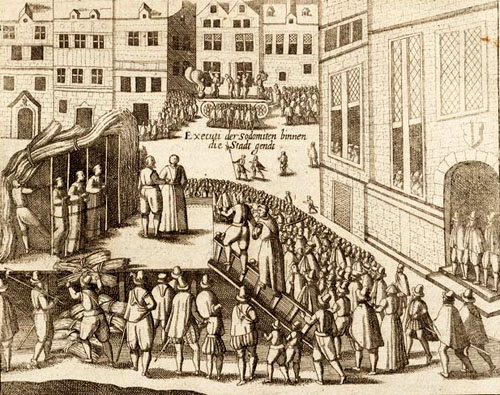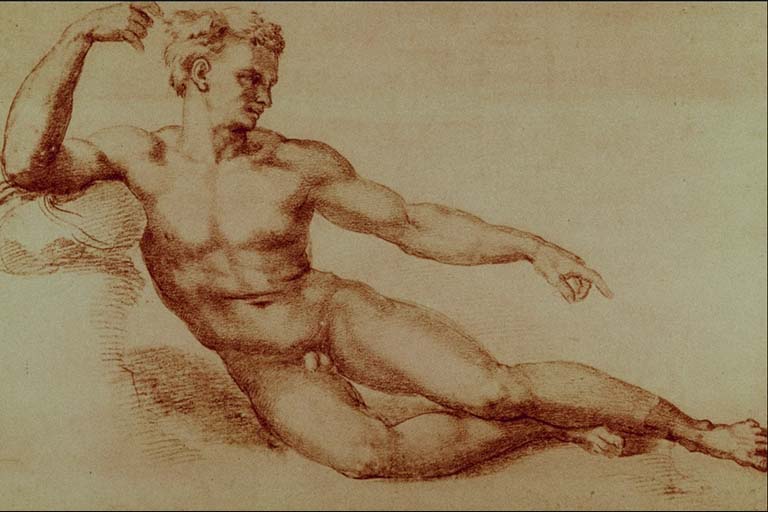This is going to be different from my other A to Z posts. While all the other ones are designed to illustrate that there is nothing new under the sun, this post is going to be about an area in which significant progress HAS been made - not so much because we're so awesome, but because 16th century conditions were so horrifying.
Throughout history, some cultures have tolerated (or even endorsed) homosexuality to varying degrees, but Judeo-Christian culture has never been one of them. Both the Old and New Testaments strongly condemn homosexual practice, and those proscriptions were taken seriously throughout Europe. Thomas Aquinas, who lived during the 13th century, ranked sodomy as second only to murder among all sins. But as a practical matter, during the Middle Ages the general policy was often "don't ask, don't tell." There were no police forces, after all, and presumably not many cities wanted to waste their scarce judicial resources on victimless crimes.
All of that changed dramatically during the Renaissance. Ironically, the historical period famous for major artistic, intellectual and scientific advances was also the period when most of Europe, led largely by the Catholic Church, enacted brutal crackdowns on gay people. Part of the hysteria seems to have stemmed from the fact that the practice of sodomy was widely believed to contribute to the spread of both the Black Plague and syphilis. In short, if there was a queer culture in 16th century Europe, it had to remain deeply hidden, or its members would risk being executed.
 |
| Execution of homosexual monks in Ghent |
In Spain and all its colonies, the Spanish Inquisition began in 1478, and it was not formally abolished until 1834. At least 500 people were prosecuted as sodomites (a term often used interchangeably with homosexuals, although it also had broader meanings) in Spain during the Inquisition, and the first sentence of burning (to death) was carried out in 1572. Everything is relative; it's been noted that the Inquisition executed relatively few consenting adults for sodomy, focusing instead on rapists and child abusers. In 1532, the Holy Roman Empire enacted a law making sodomy punishable by death. In France, first-time offenders were castrated; second-time offenders were punished by some form of dismemberment; third-time offenders were burned. Lesbians received punishments of similar severity.
In 1533, Henry VIII of England and his pal Thomas Cromwell passed the Buggery (a.k.a. sodomy) Act, which provided that all acts of male-male sexuality were punishable by hanging, followed by confiscation by the government of all one's property. Even priests, monks and nuns, who could not be prosecuted for murder, could be convicted and hanged as sodomites. Conveniently enough for the King, this would lead to the confiscation of monastery lands. Perhaps this was why the Catholic Queen Mary abolished the Act when she assumed the throne in 1553, and why her younger sister, the Protestant Queen Elizabeth I, reinstated it when she succeeded Mary ten years later.
The city of Florence was well-known in the 15th century as one place that did have a fairly open and widespread homosexual culture. In 1432 the city established a troop of Officers of the Night, whose job it was to root out sodomy. From then until 1502, more than 17,000 men were charged with sodomy in Florence, and 3,000 were convicted.
Michelangelo, arguably the greatest artist of the Renaissance, was widely believed by his contemporaries to be homosexual. The debate as to whether or not he actually was still rages, but the fact is that he was never prosecuted for sodomy (unlike Leonardo DaVinci, who actually seems to have been asexual, but was charged - probably falsely - with sodomy by a rival painter and was jailed for a few weeks). But then again, Michelangelo was Michelangelo. His genius was undisputed, and it's reasonable to believe that he was considered above the law.
 |
| Michelangelo drawing |

Oh wow. I knew gay people had a rough history but I had no idea they were persecuted this severely.
ReplyDeleteStephanie, thank you for being such an intrepid blog-visitor this close to the end of the Challenge. I know I ran out of steam a long time ago, and I think that's the case with a lot of other A to Z-ers too. You rock!
DeleteLOL, at this point, I'm only reading the people who comment mine, which is what I always do. I wish I had time to read new ones...that's what it's all about, right? Too much going on. Also, thanks for sticking with me despite my subject matter. You might want to skip to U on mine...that's the next one without a corpse!
DeleteUnfortunately in many countries around the world they HAVEN'T come very far on gay rights in the last few hundred years. I knew most of this but had no idea Da Vinci was accused or the exact numbers. Thanks for the knowledge!
ReplyDeleteSadly, there are still places in this world that for all practical purposes are still in the 16th century, and despicable groups of people that want to drag everyone else back there too. But there are also reasons to hope. Thank you for visiting.
DeleteIt's been a sad history for LGBT people. Even today there are still laws against sodomy. They aren't really enforced, but I'm pretty sure there are still some states with those laws.
ReplyDelete~Ninja Minion Patricia Lynne aka Patricia Josephine~
Story Dam
Patricia Lynne, Indie Author
And yet living anywhere in the U.S. is still hitting the jackpot compared to, say, Nigeria.
DeleteLincoln once commented that both southerners and northerners read the same bible and come to vastly different interpretations. He, of course, was talking about slavery. Now we roundly condemn the practice. Perhaps one day we'll look at biblical references to homosexuality the same way. I can't help but wander how closely the biblical anti-homosexuality references are to the desire to increase the population, which in biblical times would not be a concern about overpopulation as it is today but of underpopulation. Glenda from
ReplyDeleteEvolving English Teacher
Glenda, thanks for your interesting perspective. I think a desire to increase populations could well have been behind some of the homophobia, but it doesn't explain why male homosexuals were often persecuted much more than women. To me, that smacks more of fear that the "natural" order would be disturbed if men didn't marry women and thus control them.
DeleteWow, I never knew gays were persecuted so far back in history. You did a lot of research here - well done!
ReplyDeleteCarol at My Writing Journal
Thank you, Carol. Because this was only one of my 26 A to Z posts, my research was pretty superficial and I'm sure there is plenty more to learn.
DeleteMy impression is that the ancients Greeks were quite cool with homosexuality pre-Christianity. Romans times onward things changed with Judaism and then Christianity.
ReplyDeleteSo ironic that priests could be prosecuted for homosexuality in the middle ages but seem to be above every law nowadays.
As usual a well researched post and a delight to read. Kudos!
Nila, you're absolutely right. The Greeks were very comfortable with the idea that sexual preference runs along a spectrum, not a binary divide. But they also had very indulgent attitudes toward men having sex with young male slaves or servants - probably a lot closer to the abusive-priest scenario than any of us would like to think about.
DeleteSuch a heart-breaking history. Kudos to you for this well-researched piece. Clearly there is still so much more that needs to shift in our collective consciousness, but I remain hopeful we can do it.
ReplyDeleteThank you, Deborah. I see reason for hope too. When I was growing up, I never would have dreamed that there would be such a thing as same-sex marriage during my lifetime.
DeleteThis is a part of history that should be taught in the classroom. As you said, not because things are so great now, but to show how awful the history is, and how it developed...
ReplyDelete@TarkabarkaHolgy from
The Multicolored Diary
MopDog
Thank you. I know I'm only skimming the surface here. If I ran a school, I would make all the kids learn about the life and death of Alan Turing.
Deletedark facets of human civilization, but the bigger issue is, will the society be ever free of dark facets, for as the times change new areas of darkness become visible
ReplyDeleteVery perceptive comment. My guess at the answer to your question would be no. Thanks for visiting.
ReplyDeleteJ here, of the #atozchallenge Arlee Bird's A to Z Ambassador Team. Tonight, YOU have been #COMMENTMOBBED with love from #azchat.
ReplyDeleteHow has the challenge been going for you so far? Are you meeting your goals of posting and hopping to other blogs? 3/4 of the way done!
My blog's giveaway is still going. I'm encouraging everyone to visit more stops.
http://jlennidornerblog.what-are-they.com
Yes, a very strange history. There are waves, when you look at history in a large scope, of when and where it's okay to admit to being a homosexual. Nearest I can tell, there's a relative closeness to war. During large wars and shortly after, when the population has decreased, people are less accepting of non-breeders. I read a long, detailed essay about this which blew my mind.
Hi J, thank you for your visit. I'd love to see a cite to that essay!
ReplyDelete"Even priests, monks and nuns, who could not be prosecuted for murder, could be convicted and hanged as sodomites." This fact alone is atrocious on so many levels.
ReplyDeletePolitics being politics it's the same as the man who votes against abortion rights but gives his mistress the money to have one.
Will things never change?
Very intersting article. These are information that isn't easily foudn out there. Thanks for sharing.
ReplyDelete@JazzFeathers
The Old Shelter - Jazz Age Jazz
Thank you, Sarah! I'm obsessed with the 16th century, but It definitely had its dark sides.
ReplyDelete